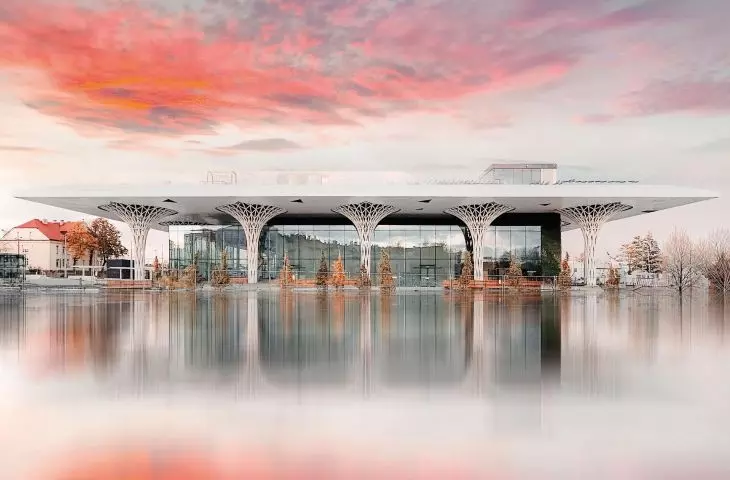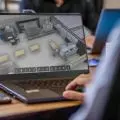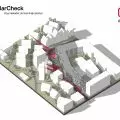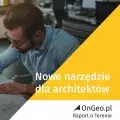The Metropolitan Station - the main element of the Integrated Transportation Center for the Lublin Functional Area - has clearly marked Lublin's presence on the transport map of Poland (the development recently won the World Architecture Festival Award 2024 in the Transport category!). The point, which integrates long-distance, regional and city transport, buses, vans and trolleybuses, will eventually serve almost 70 directions. This task is to be supported by 43 stands for buses leaving for further routes, parking spaces for 174 cars and for almost 70 bicycles, as well as a three-story eye-catching building, which - according to the plan - is to be overgrown with greenery. The entire project site covers nearly 30,000 square meters. The cost? Nearly 340 million zlotys. We talk about the implications of relocating Lublin's train station, scale, challenges, comparisons and solutions with its lead designer, Magdalena Federowicz-Boule of the Tremend studio.
Magdalena Federowicz-Boule - architect, president and creative director of the Tremend studio, which has won numerous awards in international competitions for hotel conversions, including in Paris, Budapest, Barcelona and Ukraine. She is the author of, among others, the Metropolitan Railway Station in Lublin and the Łódź Fabryczna Railway Station. Initiator and co-founder of the OW SARP Circle Architects Without Borders, Architecture Sans Frontieres, member of OW SARP, belongs to the Society of Interior Architects and serves as vice-chair of the section of architectural works in ZAIKS.
Ola Kloc: How does the change of location of the bus station in Lublin, from closer to the center of Podzamcze to the Za Cukrownia neighborhood, affect urban planning and development of the city? What were the assumptions behind this "move"?
Magdalena Federowicz-Boule:The change of location is, of course, due to the assumptions of the City, for which the project was carried out. How might they be affected? There are several aspects, including urban and ecological. From an ecological point of view, it seems that grouping transportation in one place is appropriate. People who come by rail don't have to change or take a cab to go to the other end of the city and take a bus there, and vice versa, people who come by bus don't have to move, no traffic jams are created, no additional public transportation is needed. As for Lublin, the center is not at the PKP station, but we hope that - as is happening in many Western cities - the development of the PKP station and transportation hub will contribute to the revitalization of this part of the city, the development and expansion of post-industrial areas, areas that were in some sense undeveloped, degraded. Revitalization does not mean that we will create a center there, the idea is to create an area that will become pleasant for residents, for people passing through, frequenting there, an area that will create certain social conditions for these people to function. An example of a place where the revitalization of a train station has influenced the revitalization of neighboring areas is Lyon and many other cities in France. Transportation brings a certain area closer to the center, but also to other places in Poland.
situation
© Tremend
Ola Kloc: So why isn't the new train station connected to the PKP station? This is a hindrance to passengers.
Magdalena Federowicz-Boule:Unfortunately, this is a property problem. The land that was subject to development is not owned by the PKP; moreover, it has several owners. What we managed to do was to develop the area that was intended for this investment, while trying to reconcile - because we also had agreements with the PKP - the different purposes and functions of various users.
cross sections
© Tremend
Ola Kloc: Does Lublin really need such a large station? What are the reasons for the scale and number of bus stands?
Magdalena Federowicz-Boule:This was a requirement that we got as a design guideline, that is, the program. I also initially wondered about it, entered into discussions, asked if there were too many of these buses and all that. Ultimately, I think creating two stations would also be a hassle. This is a program that, as I understand it, takes into account the development of the city and combines long-distance traffic with urban traffic, trolleybuses, buses in one place, anticipates a certain future, hence the large number of stations. We are talking about the scale of the whole premise that is around, the number of stops; the building itself is not large, we tried to make it so that it can handle the task at hand, and not be scaled up.
projections
© Tremend
Ola Kloc: The building is located right next to the 19th century railroad station building. How did this neighborhood influence your design?
Magdalena Federowicz-Boule:Our idea was that the building we would create should not dominate in scale. So we took into account various urban studies, invasions from neighboring streets. We wanted to create simple architecture, a building within a building. The only decorative elements are the columns, the rest is a very simple glass block, which was not to compete with its surroundings.
The Metropolitan Station for ZCK Lublin is adjacent to a 19th century railroad station
Photo: Aleksander Malachowski
Ola Kloc: Please tell us more about the solution in which the larger block houses the smaller one.
Magdalena Federowicz-Boule:Everything comes together - architecture and ecology. Thanks to the "box within a box" solution, we can heat only the inner part, and what is the outer shell, surrounded by a glass facade, will be heated through recuperation, or heat recovery. The bane and problem of all public facilities is precisely the operating and maintenance costs. Here the idea was to heat only the part where the real functions are located - the workstations, the quiet waiting room, i.e. the one where we undress and sit down, all the cash registers, the parts serving the station and the toilets, and the rest, i.e. this second skin, which is heated through heat recuperation, is to be a waiting room, where not necessarily everyone flattens out, there is an intermediate temperature.
Thanks to the box-in-box solution, only the inner parts of the building can be heated, the other zones - the "second skin" of the station - are heated through recuperation
photo: Rafał Chojnacki
Ola Kloc: What is most characteristic of the building are the openwork columns. They seem to have been inspired by the Lublin cutouts. What was the process of creating them like? Did you aspire with this solution to create a new symbol of the city?
Magdalena Federowicz-Boule:When we start a project, we don't think we want to create our life's work. The first sketches we did were indeed inspired by locality, that is, these cut-outs. We started from a 2D plane - when you look at the pole from above, you can see the pattern of the cutouts. Then, when we started to create a 3D solid, a structure was created to support the roof of the station, to support the greenery, which will disappear over time, because it will be covered by vines. This solution of the pillars began with an idea we call local touch, or localness, a reference to the coat of arms of Lublin, where green elements also appear [vertically growing vines - editor's note]. We still have to wait a while for the effect, the station will change its appearance when it is overgrown with greenery.
The most characteristic element of the station are openwork pillars; in the future they will be overgrown with vines
Photo: Aleksander Małachowski
Ola Kloc: One of your main goals in this project was ecology. Please tell us about the solutions you introduced to achieve this goal.
Magdalena Federowicz-Boule:The form itself, i.e. lump within lump(box in box), the partial heating I mentioned. Ventilated, unenclosed parking lots, which allowed us to reduce the number of systems, we also planted trees at the parking level, which, when they grow, will be visible from the square. We also have technical solutions, i.e. photovoltaic panels - due to the large number of pitches imposed in the program, we wanted to use them ecologically, i.e. make glass roofs that will support photovoltaics that produce energy. Ground source heat pumps, natural ventilation of the entire station. Large roofs not only shade and protect from rain, but also from too much sun. A concrete wall with a map of Lublin, another local touch, is supposed to absorb heat and give it back, thus supporting air recuperation for the building's second skin space. Of course, there are also green gardens on the roof and a green wall, or biophilic design. We wanted it to actually be green, so that people would enjoy meeting in this place. There are also other small elements, such as anti-smog concrete.
The large roofs are not only meant to protect against rain, but also against too much sunlight
Photo: Rafał Chojnacki
Ola Kloc: While climbing plants that overgrow poles are a great solution for covering vertical surfaces, vertical gardens are controversial - they require more resources, both financial and environmental, in their creation and subsequent maintenance.
Magdalena Federowicz-Boule:We worked with greenery specialists on these solutions, as we are not specialists ourselves. The green wall was to refer to the People's Park, connect it to the station, and then seamlessly ascend to the roof. There are a lot of solutions that are difficult, perhaps also, as it seems, costly, but they result in improved air quality, visual aspect, so we didn't want to give up on them. I know that these are not cheap solutions, but I think that the Lublin station is worth it.
Ola Kloc: How do you feel about comparisons to the Gardens by the Bay in Singapore (designed by Grant Associates, WillkinsonEyre; opening in 2012) or the station in Lisbon designed by Calatrava (opened in 1998)?
Magdalena Federowicz-Boule:There are so many beautiful architectural solutions in the world that we can always find some reference or reference. We started this project six or seven years ago, I only saw the gardens in Singapore live this year. Human references and human imagination are immense, so if someone associates it, they probably do. We were not inspired by it, because when we started this project, we didn't know these gardens. And as for Calatrava - I would like to be compared to him, but I don't think that reference is there. The only thing that could be some reference to his work is the combination of architecture and construction. I consider Calatrava's greatest discovery to be that construction is not only a structural element, but also becomes an element of architecture. And is our project similar to Calatrava's? In my opinion, no, but of course others may have different associations.
The architects wanted the building not to dominate the surroundings with its scale
Photo: Rafał Chojnacki
Ola Kloc: The project began in 2017, although we still have to wait for the final result. In 2024, the first buses took off from it. What has been the biggest challenge in this multi-year process?
Magdalena Federowicz-Boule:Creating ideas is a wonderful thing, and that was the very enjoyable part for us. As for the biggest challenge - as architects in Poland, we have to face certain administrative procedures, arrangements, technical problems, of which there are a lot in such an area of the city as we faced here. Ownership arrangements, translator arrangements, various networks, gestors, the very program that was imposed, were not easy for us. If someone says "the station is expensive," I would like them to pay attention to how many streets have been rebuilt, the number of networks, and the fact that these measures will serve not only the station, but the revitalization of this area in general, the investors who will move in and, we hope, develop this part of the city. So this is an investment in the future, so to speak. I guess that was the most difficult thing for us - all those discussions and the number of people and organizations involved in the whole administrative procedure, and the fact that we wanted to do it as well as possible. One always wonders if certain decisions one makes are the right ones in the context of discussions with other users or other stakeholders.
a point integrating long-distance, extra-urban and urban transportation, buses, vans and trolleybuses is ultimately to serve nearly 70 directions - this task is supported by 43 stands for buses leaving for further routes; due to the large number of stands imposed in the program, the architects decided to use them ecologically, i.e. to make glass roofs that will support photovoltaics
Photo: Rafał Chojnacki
Ola Kloc: Would you do something differently today?
Magdalena Federowicz-Boule:I think it's always possible to do things differently. What would we be able to fight to do differently? I don't know. For sure, it would be nice to connect the train station with the bus station. This was one of our proposals and concepts, it didn't work out. It would have been nice to solve some of the problems of the PKP station, which were beyond our scope. We also dreamed of a woonerf on the street next door, which was also not realized for various reasons. There are a lot of things that we would like to see realized, for some they are good, for others bad. To us they seem right, which is why we proposed them at the concept stage. Not everything has been implemented, but I also understand why. Everyone sees their own interest in it, every institution, every resident around, and in the end you have to reconcile it all.
It's just like in life, we tried to do the best we could, some like it, others less so. I hope that in the end it will be well appreciated and that the three goals we have set for ourselves, namely the creation of a transportation hub, the revitalization of the area and ecology, will bear fruit in the future.
Ola Kloc:Thank you for the interview.
interviewed by Ola Kloc
Photo: Rafał Chojnacki, Aleksander Małachowski, Bartek Barczyk
© Tremend
more: A&B 05/2024 - Tremendous,
download free e-publications of A&B

















































